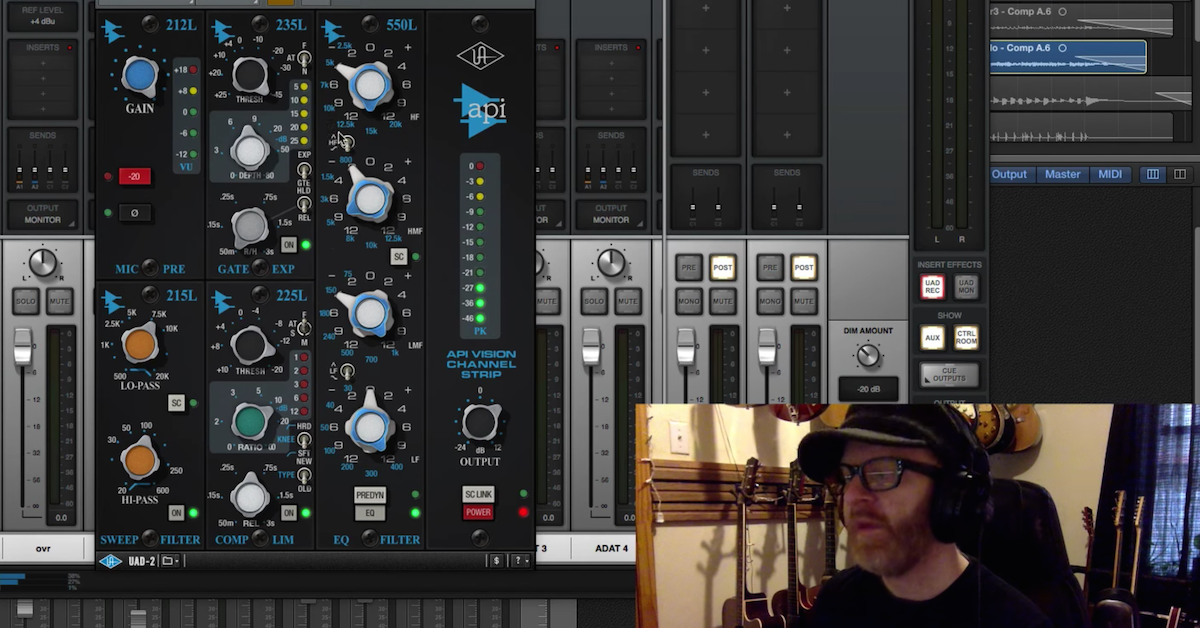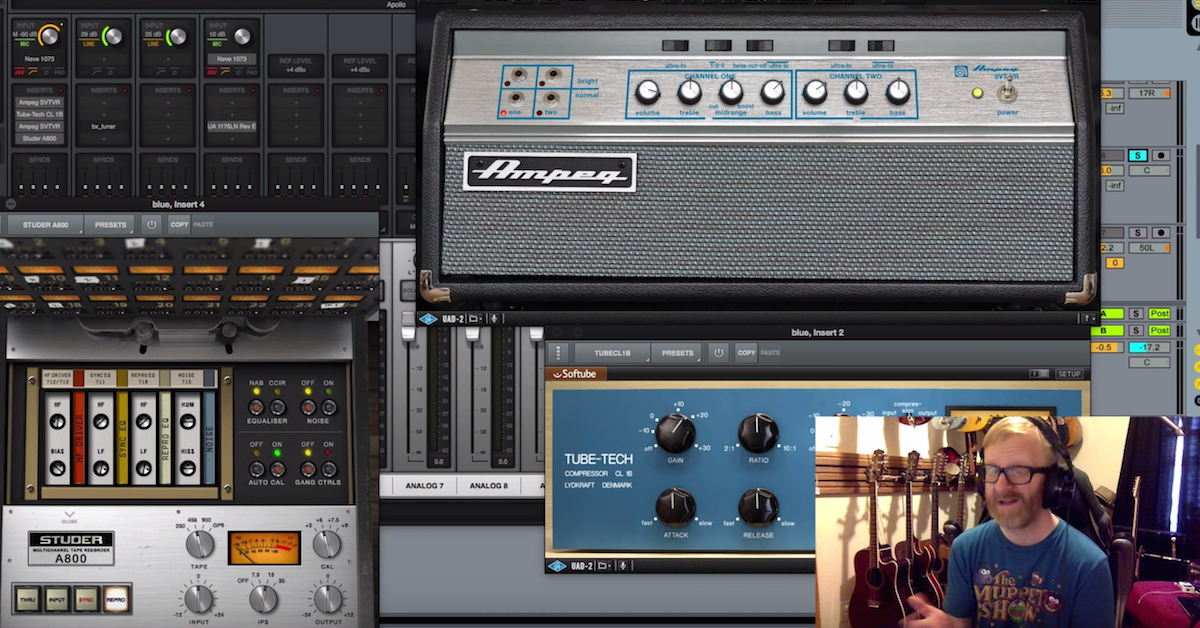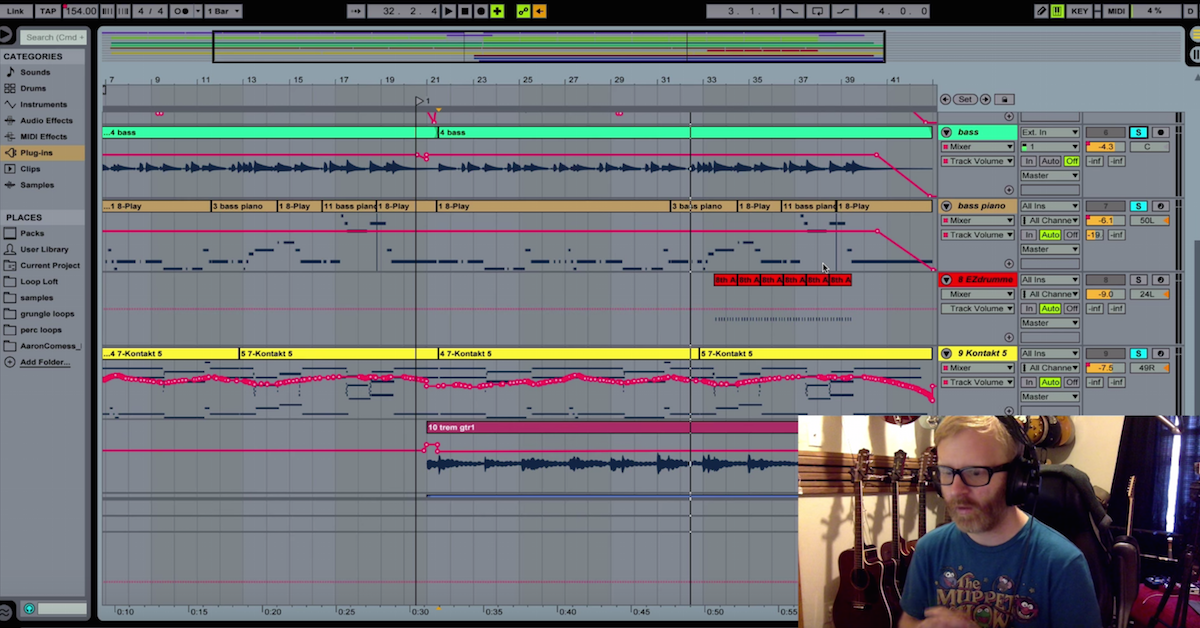Production Breakdown: Dirt Magnet by Mark Marshall
They wanted something that was kind of clanky, bluesy, Tom Waits-y sort of vibe, and to get this started, I knew that the drums were going to kind of be an important part. The drums always are in Tom Waits music. He likes a lot of noisy and almost profound sounds.
The EZ Drummer, has a library called “Twisted Kit,” which is really, really great for this. It has a lot of — you see like pots and pans, stomps, claps, and just all kinds of different clanky things, which is really cool.
Before I get too deep into that there, let’s actually listen to the track.
[mix]
As you heard, the second 30 seconds of the song progressed a little bit more with more percussion. This is a pretty standard trick for this sort of sync licensing that you do all the song, and then the second 30 seconds, they want a little more in it, right?
So at this point, I’m not adding any more melodies or anything like that, I’m just filling it in and making it sound a little bigger, and I added a little more percussion.
Let’s start with the drum groove there, because I started talking a little bit about this before. The groove starts off with…
[drums]
Pretty clanky, right?
Now, I added an additional track below that. I was adding some more… I labeled that one “Clank.”
[drums]
Yeah, this is the part you hear off the top.
[clank tracks]
Let’s listen to the bass guitar.
[bass]
I used this UAD Ampeg plugin. I’ve been using this a lot recently. Pretty simple, I think I pulled the stock setting. I have a few customized settings on here, because I’ve been using it since I recorded this, but I didn’t have any of this stuff setup, it was fairly basic.
Into an LA-2A, which I had set as following, and at the end, the chain was the Studer A-800 plugin. That’s pretty common for me to use those three plugins in conjunction.
The bass does make a big difference. I think you’re going to have to mess with different settings or different options, depending on the bass you’re playing. I really like Fender P-Basses for recording. I find them to be the most versatile. At least with the music I’m doing.
I tend to use two of them. This particular recording, I used a 1971 P-Bass, and yeah, it does sound a little different than my more modern P. Not that my modern P doesn’t sound good, I just think that the 71 is a little punchier in some ways, and it’s not as out of control in the low end. I think the new P-Bass may just be a little girthier.
Again, not better, not worse, but different, and having knowledge of your instruments is kind of why I have so many different instruments, but having this knowledge can kind of simplify things when you’re doing a recording just knowing what each instrument really delivers.
I think for a lot of this TV stuff, the thing is, regarding the mixes is that you’re not going to spend as much time with it as you would you doing a record, so anybody who makes their living from mixing records might hear some of this stuff and be like, “Oh, well here’s what I’d do, I might do this, I might do that,” but the name of the game is just print them out really quickly, so I try to make a lot of decisions that I know are going to be — neutral is not the word, I’m not necessarily looking for neutral, but I’m looking for predictability a little bit in the sense of I know how all of these elements are going to add up together.
Like, for instance, I want to be able to do one of these in under an hour, right? Because they’re royalty based, and eventually, it’s about how much of them you get in TV shows. If you’re spending six hours on the mix on one of these, it’s eventually going to be a really slow process for you to earn income from them.
That doesn’t mean that I cut corners in the sense that I don’t care or anything like that, but I try to do a lot of pre-mixing going in so that I don’t have to sit and tweak for hours.
There’s really not much on this track, so let’s talk about the guitars. Both of the guitars were cut with a ’68 Gibson ES-335 with the original humbuckers.
You know, the 335s I think are really fun to record with, because the fact that they’re semi-hollow, it just gives a little bit of a more woody tone I think around the notes. I also use a lot of solid bodies, like the Les Paul, but even staying in the Gibson family, like an SG or a Les Paul, they’re just a little bit I think more tight and direct sounding with the note.
The 335s are hollow, like a 330 or 335, this is just to have a little bit more of an aura I think around the note, and sometimes, I use them just for that matter, especially I think when using amp sims, and I did use an amp sim for these guitar sounds.
Let’s look at what one I used. I used this Vintage Amp Room from — it’s one of the UAD plugins. Softube makes it.
If I look at the settings, this has been kind of my go-to setting when I’m using pedals, so I’m trying to get it fairly clean, and so I can plug my pedals in and use that as a basis for a tone. I find that really helps a lot, like when I can use the pedals as the front end, but the tremolo is off, and you’ll notice I cranked the treble.
I pulled the master volume back a lot, because I really didn’t want it to overdrive that much. These plugins, I’ve mentioned in other videos, but they’re pretty hyped when you open them, and I find that’s not often where I will even get an amp to be when I’m using it.
So this is, I think, a little closer to what I would have. Some Fender amps, definitely not a Twin Reverb, but maybe a Deluxe or a Vibrolux or something like that.
I always use the Studer A-800 plugin. The only thing I do is I always turn the noise off. I don’t want the noise, but everything else, I just leave it stock. It’s 15ips, and then I just roll with it. It just makes everything sound better.
[guitar]
There’s a couple of components to this guitar sound, aside from the amp sim and the 335. I used this Effectrode Tube Drive pedal. I use this a lot when I use amp sims, even if I have the gain really low.
There’s just tubes in it. It runs at amp voltage. It feels like an amp with some tube sag in it, and it really brings it to life in a way I think that it’s hard to do with an amp sim, and I’ll often try to get like, that Vintage Amp Room pretty clean, and if I want any sort of overdrive, I’ll use it from this pedal.
So I’m using this pedal to some degree as a preamp. I use it a little bit more on that. You can hear overdrive in a little bit. The settings, I think I had the bass boost cut, and I didn’t have the treble boost on.
I was also using the Tube Drive into this Strymon El Capistan to get a little bit of that Mark Rubbo slapback echo kind of tone. I often will roll off a little bit of the high end for the guitar, especially when recording, and I didn’t have much of the wow and flutter up on that one. I think I had it all — I really like this knob a lot. I’ll often kind of crank it so it warbles.
I changed one element in the second guitar part, which we’ll hear here.
[guitar]
You listen to that tone, there’s just something a little different about it, and I think your mind would be wondering, “Is it a fuzz? Is it an overdrive? How are you getting that sound?”
The answer to that is I was using this Germania pedal. It’s great. Pretty much a Range Master treble booster. They are really cool pedals, and they act differently than a fuzz, and a distortion, and an overdrive.
They were used a lot in the late 60’s, early 70’s. Jethro Tull, Aqua Lung, that’s a very Range Master heavy sound, as well as some of the early Black Sabbath records. Actually, Tony used a Range Master.
To me, it’s just the Range Master has more attack, so sometimes, a fuzz is a little soft and a little pillowy, and an overdrive is just a little too sharp. I kind of think the treble booster can — as far as the attack goes — can do some interesting things. Like, it’s fuzzy, but it still has a little bit of a stronger attack.
I use this in front of the tube drive pedal, because really what the Range Master does is it’s like a booster pedal, but it’s not just a clean boost. It adds some frequencies and harmonics, and some distortion, but it’s designed to just really slam the front end of your amp.
Now, this doesn’t really work so well with digital recording, because your converters aren’t going to like that, right? They’re not a valve amp, so they’re going to freak out if you start hitting it.
This can I think add up to at least 20dB of gain, which is not a good combination.
So, to get around that, I used the Tube Drive pedal after this treble boost, because I — it’s going to act as a valve amp, because it does have valves in it. So I cranked this up pretty good. It was hitting it pretty hard. Now, I turned the gain almost all the way down on the Tube Drive, because I didn’t want a lot of overdrive coming from the Tube Drive pedal, even though that’s what was going to happen, I didn’t want to add a lot more.
So this is kind of just slamming it, and it acts — I think a lot like kind of how Jethro Tull was getting those sounds with the Range Master and the treble booster.
There are a couple of companies that make them. This guy is not making these anymore, but if you look up a lot of Range Master clones, there’s companies that make replicas of them. It’s kind of a really cool flavor to have in your tone locker.
Last thing I added to counter that lead guitar part, the treble booster part that we just heard, was I added an organ. A Farfisa Organ.
[guitar and organ]
That’s it. Very simple production. It doesn’t need a lot of elements, as often these type of cues are in the background, so the fact that they’re not super busy is actually better and less distracting.





